Yesterday morning, while I was in the busiest part of putting this issue together, I got an alert on my iMac telling me that my average daily screen time had increased. My computer had never expressed any concern for my wellbeing, so I couldn’t dismiss it as a worrywart. To be sure, in the past two weeks I had been spending a lot of time in my study and of late hadn’t been feeling myself but logy and more forgetful than usual. I logged off, loaded my coracle and a bit of gear into the truck, and headed for the nearest body of water, less than a mile to the east of home.
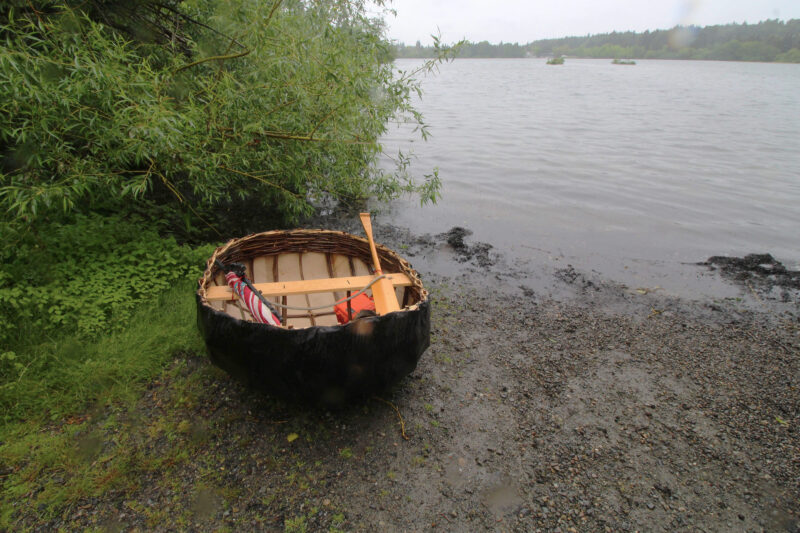
With my paddle, umbrella, and camera tripod bungeed to the thwart and the rest of my gear in a sling tote, I made the 100-yard portage in a single carry. The coracle goes overhead, upside down, with the thwart resting across my back and shoulders.
I hadn’t paddled my coracle since I’d tested it with a temporary skin two-and-a-half years ago and now its hull, as rounded as a walnut shell half, slipped away from me every time I stepped in it with the least bit of weight. When I did get myself planted on the thwart, it felt like sitting on an exercise ball, and my hips were in constant motion maintaining balance. There was a bit of a breeze, barely enough to quiver the slender leaves of the willows lining the shore, and the ripples on the lake were too smooth to darken the zinc-gray water.
A light rain was falling as I sculled away from shore and, where the drops fell, the rings made by their impact expanded and wove themselves into the rings of other drops, covering the surface with an ever-changing chainmail pattern. The island I was headed for, the only one on the lake, was only 150 yards from the beach, but I took a meandering course to its shore, an overhang of burnt-umber mud and exposed ebon-hued roots.
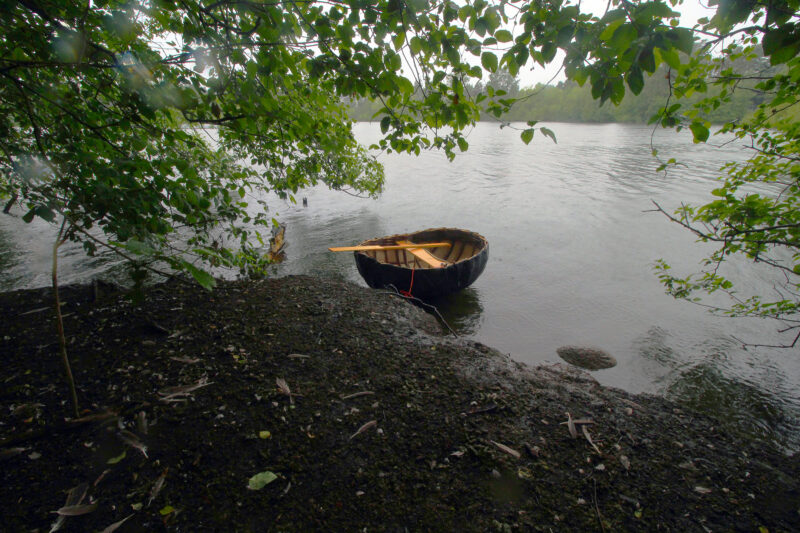
The crossing to the island was a short one, just 150 yards from the launch site on the lakeshore visible in the distance.
I’d brought lunch and backed away from the island to float in its lee while I ate. Putting up the umbrella and taking my sou’wester off changed the sound of the rain. The muffled pattering on the hat’s soft waxed canvas was replaced by a staccato tapping as sharp as fingertip snaps of static electricity. The curve of the umbrella surrounded me with rain’s music, a sound that can capture my full attention and push aside thinking as surely as gazing into the flickering flames of a campfire.
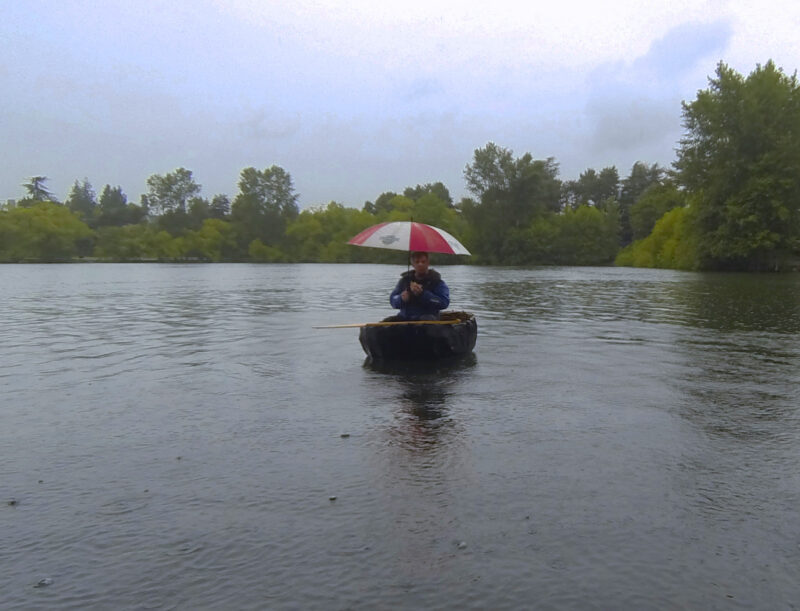
Drifting in the lee of the island, I had a quick indulgent lunch: a deli sandwich, a can of ginger ale, and a chocolate truffle.
My iMac was right to caution me about accumulating screen time. Sitting in one place focused on the same thing for hours on end day after day dulls the senses and the connection they create to whatever is around us. In psychology, that’s referred to as sensory adaptation, the process by which we become less sensitive to constant stimuli. It is not without benefit. To get constructive work done, it helps to insulate ourselves from distractions. And it happens without our knowing it. My refrigerator makes a humming noise while it’s running. I’m often unaware of it until the instant it stops. What I hear is the absence of the noise. I have tinnitus and, fortunately, that unending whine slips from my consciousness most of the time. Similarly, I’m unaware of the taste of my own mouth or the scent of my own breath. It’s not so easy to experience vision lost to sensory adaptation, but I’ve done it a few times by lying in bed motionless and staring at the light fixture on the ceiling. If I can keep from shifting my eyes, I can make it disappear into gray.
The screen time isn’t just about the time looking at computer-generated images. It’s what happens to the other senses and the potential of their growing dull with disuse. Boating, especially in a small open boat, can be an effective remedy. The five senses, six when you include the proprioceptive sense, are all heightened by surroundings that are never the same from one moment to the next.
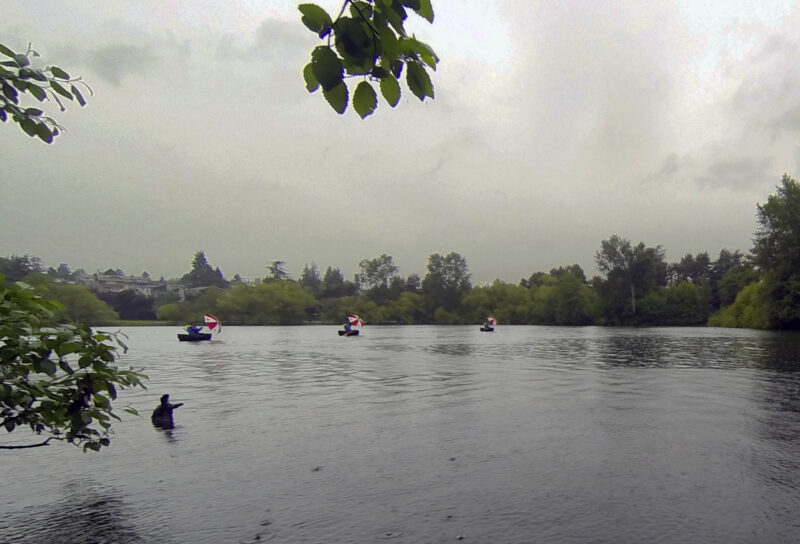
The umbrella made a surprisingly effective downwind sail and could pull the coracle faster than I could paddle it. (Time lapse photo)
When I left the island to head back to the launch site, I paddled out of the lee into the wind and lowered my open umbrella. As it caught the wind, I held the paddle over the starboard side to serve as a skeg and point the coracle in the right direction. As I approached the shore, a gust diverted by the trees and brush spun the coracle around like a teacup ride in an amusement park. I was ready to face the screen again. ![]()
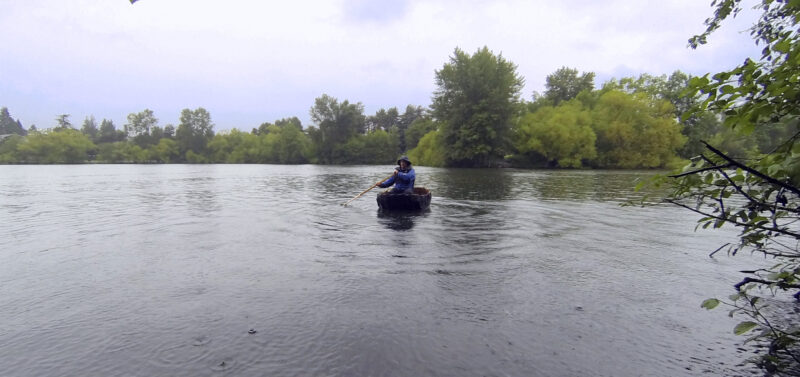

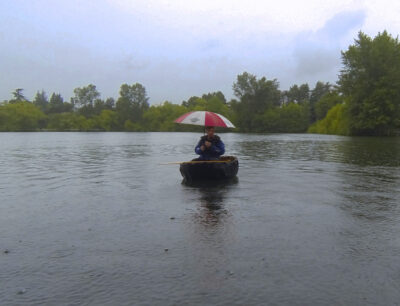
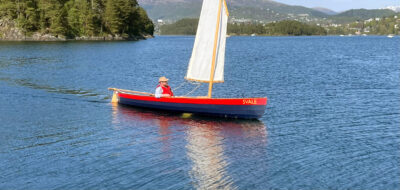

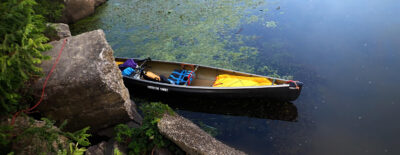
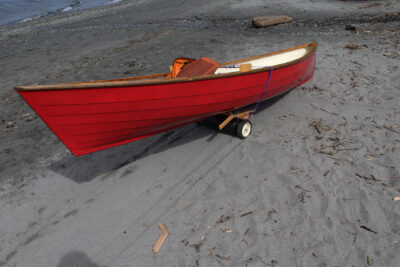
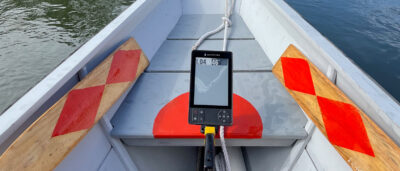
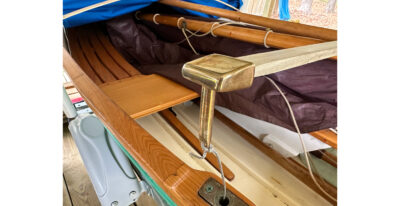
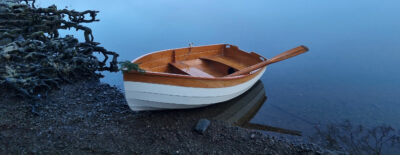
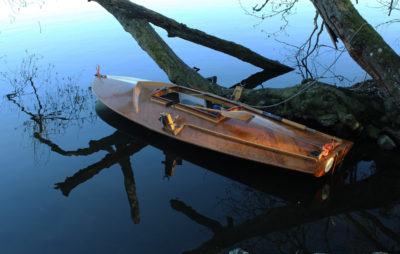
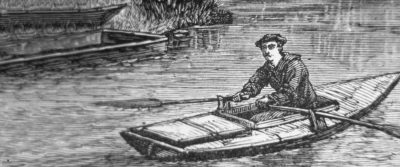
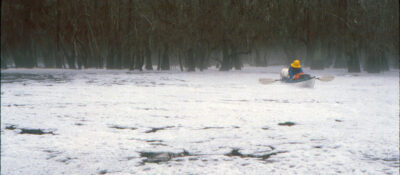
It gives “going for a spin” a whole new meaning, definitely good to get away from the screen from time to time. How does manoeuvrability and stability of the coracle compare to your tender FAERIE?
My traditionally built coracle in this story isn’t as much fun to paddle as FAERIE. (For a description of FAERIE, see “A San Juan Islands Solo” and scroll to the bottom.) The coracle is heavier, larger, and rounder and the size and shape make it more difficult to paddle. It sits higher in the water, and to reach the water I had to make a paddle about 18” longer than FAERIE’s paddle. FAERIE is roughly rectangular and the bow, being lower and straight across, is closer to me and to the water. The coracle’s rounded bow puts its front extremity significantly farther away. There are other types of coracles in the UK with squared-off bows and some of those even have tumblehome, features that make for an easier reach to the water. Their squared front ends, like FAERIE’s, continue below the waterline, providing support for the paddler, just as a broad transom in an outboard skiff supports the weight of the motor and skipper.
With my coracle’s rounded bow, I often paddled off to one side. That would pull the coracle at an angle, increasing the drag and making progress slow. FAERIE has a flat bottom and hard chines, giving it more stability that the coracle. For the coracle, I followed the traditional method and weighted the bottom during its upside-down construction and that flattened the curve a bit, but it’s still rounded not as stable as I’d like. One of my goals for the coracle was to do overnighter and I’m hoping that a load of gear aboard, and perhaps some water ballast, would increase its stability.
How were the photos made??
All the photos of the coracle with me aboard were taken with a GoPro Hero3 Black, a model introduced in 2012. I mounted it (in its waterproof housing) on a tripod that I stood in the water at the island’s edge. I set the camera to shoot a still frame every 10 seconds and then paddled around within its view. For the sailing shot, I opened six of the image files in Photoshop and chose three of them for the composite image. Because the background didn’t change, it was a simple operation to select and copy the bits of the image around the coracle in the second and third shots and paste them into the first shot. After that, I corrected the GoPro’s fish-eye distortion, cropped, and did all the usual image adjustments.
I really enjoyed your coracle article! It got me wondering how you find the canvas/roofing sealant skin compared to a nylon/urethane skin?
For the coracle, I wanted to keep to a low-tech approach appropriate to coracles. The canvas I used came from a second-hand store that often has a good supply of very heavy canvas in 5’ x 10’ pieces for $10 each. It had hardly any stretch in it, so I sewed the skin in five pieces. I wouldn’t attempted sewing if not for my Sailrite walking-foot sewing machine. I did a lot of research on the coating and most of the information came from the UK and pointed to bitumen. In the US that’s asphalt. I had used an asphalt coating to repair a leaky flat roof on my garage and it seemed to stay flexible years after application. The roofing compound was cheap and black, like the UK coracles. I did some test pieces on scraps of canvas and it seemed like it would work, but months after coating the coracle. I could hear the coating crack when flexed. The text pieces were then doing that too. I’ve been planning to add another coating, Elasto Barrier, this summer. On the outing in this article the original skin and coating proved waterproof. Whatever water might seep through the cracks would evidently get stopped by the tightly woven canvas.
Nylon and urethane would make a good skin. The fabric might not pull tight around the hemisphere shape of the hull, but the gathers could be kept small and flattened a bit more by ironing. A urethane coating, which I used for my bidarka, has aged very well and has proved durable.
Starting with a frame made of foraged saplings, I was drawn to the economy a more traditional approach of asphalt on canvas. My cost for materials was about $30.
“…covering the surface with an ever-changing chainmail pattern.”
Fantastic phrase, Chris.
“The five senses, six when you include the proprioceptive sense, are all heightened by surroundings that are never the same from one moment to the next.”
Is that the ‘scientific’ reason I am much more alert and understanding of everything around me, since starting barefoot? Because my footing is always changing, my senses are heightened? I attributed it to increased sensory input acting similarly to Ritalin, but your observation makes some more sense.
Wonderful piece.
And a wonderful way to get lost (and found) in the “surroundings that are never the same from one moment to the next.”
Two weeks ago standing on a hill 1/4 mile east of, and perhaps 200′ up from Hood Canal, I was listening to a 15-20 mph wind coming from north-north east through a mix of maples, alders, cedars, madrone, and Doug fir, and had a a long moment of being lost in the music of all that motion.
I realized, when thought came back, that the specific music of motion through the leaves was changing faster than could be measured in segments of time, or translated into sound waves, and would never, could never, be duplicated again.
I makes me smile to think that this sort of thing connects us, or should, to the pagan gods of place.
Thanks for reminding that these moments matter, are available when we look for them, and can frequently be found in small boats.
I never expected to find, in a “rainy day” story, a new 50-cent word !
What a magazine, and what an editor !